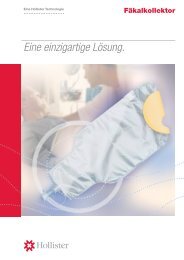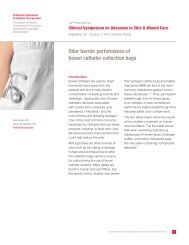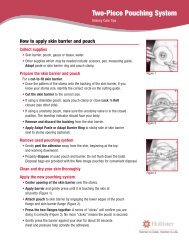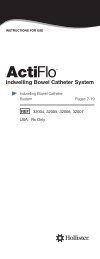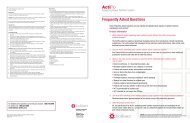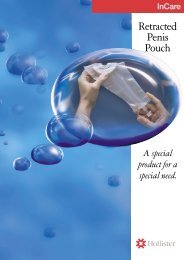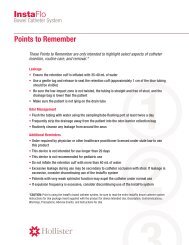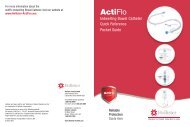Comparison of Two Indwelling Bowel Catheters on Economic Impact ...
Comparison of Two Indwelling Bowel Catheters on Economic Impact ...
Comparison of Two Indwelling Bowel Catheters on Economic Impact ...
Create successful ePaper yourself
Turn your PDF publications into a flip-book with our unique Google optimized e-Paper software.
<str<strong>on</strong>g>Comparis<strong>on</strong></str<strong>on</strong>g> <str<strong>on</strong>g>of</str<strong>on</strong>g> <str<strong>on</strong>g>Two</str<strong>on</strong>g> <str<strong>on</strong>g>Indwelling</str<strong>on</strong>g><str<strong>on</strong>g>Bowel</str<strong>on</strong>g> <str<strong>on</strong>g>Catheters</str<strong>on</strong>g> <strong>on</strong> Ec<strong>on</strong>omic<strong>Impact</strong> by Number <str<strong>on</strong>g>of</str<strong>on</strong>g> Bed Linenand Dressing Changes Per DayJ. Powers 1 , PhD, RN,CCRN, CCNS, K. Berry 2 , RN, BSN, WOCN, CWON, M. Koenig 3 , RN, M. Majewski 4 , RN,M. Tan 5 , MD, S. Poulakidas 6 , MD, B. Barnett 7 , RN, E. Stokes 8 , RN, BSN, M. Ferrari 9 , RN,S. Ambutas 10 , MS, RN, CCRN, TNS, J. Mah 11 , MD, E. C. K<strong>on</strong>z 12 , PhD, RD1) St. Vincent Hospital <str<strong>on</strong>g>of</str<strong>on</strong>g> Indianapolis, Indianapolis, IN 2) Banner Estrella Medical Center, Phoenix, AZ 3} University <str<strong>on</strong>g>of</str<strong>on</strong>g> California San Diego Medical Center, San Diego, CA4) Northwestern Memorial Hospital, Chicago, IL 5) Summa Health System, Akr<strong>on</strong>, OH 6) John H. Stroger Hospital <str<strong>on</strong>g>of</str<strong>on</strong>g> Cook County, Chicago, IL7) University <str<strong>on</strong>g>of</str<strong>on</strong>g> Virginia Health System, Charlottesville, VA 8) Sisters <str<strong>on</strong>g>of</str<strong>on</strong>g> Charity Providence Hospital, Columbia, SC 9) Cleveland Clinic Foundati<strong>on</strong>, Cleveland, OH10) Provena Saint Joseph Medical Center, Joliet, IL 11) Hartford Hospital, Hartford, CT 12) Hollister Incorporated, Libertyville, ILIntroducti<strong>on</strong>• <str<strong>on</strong>g>Indwelling</str<strong>on</strong>g> bowel catheters are used to divert, collect, andc<strong>on</strong>tain stool from bedridden patients with fecal inc<strong>on</strong>tinence 1• Fecal inc<strong>on</strong>tinence is prevalent in patients in theacute/critical care setting 2, 3• Factors such as device cost and time to manage/replacethe device may add expense• Nosocomial infecti<strong>on</strong> risk management for fecal pathogensis a key benefit and potentially could be facilitated by bowelcatheter use• A variety <str<strong>on</strong>g>of</str<strong>on</strong>g> factors and catheter characteristics c<strong>on</strong>tribute tothe effectiveness and durati<strong>on</strong> <str<strong>on</strong>g>of</str<strong>on</strong>g> use for a given patientObjectiveThe primary objective <str<strong>on</strong>g>of</str<strong>on</strong>g> this study was to assess andcompare the ec<strong>on</strong>omic impact <strong>on</strong> fecal c<strong>on</strong>tainment withuse <str<strong>on</strong>g>of</str<strong>on</strong>g> catheter A or catheter B at 12 hospital sites(catheter A, 7; catheter B, 5) in the critical care setting.Methods• An analysis <str<strong>on</strong>g>of</str<strong>on</strong>g> 146 bedridden patients (catheter A,76; catheter B, 70) was performed <strong>on</strong> the number<str<strong>on</strong>g>of</str<strong>on</strong>g> bed linen/dressing change visits per day withcatheter A or catheter B• Bedridden patients in the critical care setting requiringfecal c<strong>on</strong>tainment were followed for 29 days or untilleaving the critical care setting• Bed linen/dressing change visits per patient day (frequency <str<strong>on</strong>g>of</str<strong>on</strong>g>nursing visits per day spent changing bed linen/dressings dueto fecal c<strong>on</strong>taminati<strong>on</strong>) can be used as an indirect ec<strong>on</strong>omicmeasure <str<strong>on</strong>g>of</str<strong>on</strong>g> catheter leakage and fecal c<strong>on</strong>tainment• Routine daily bed linen/dressing changes were notincluded, <strong>on</strong>ly catheter-related bed linen/dressingchanges were recorded• The study evaluated the number <str<strong>on</strong>g>of</str<strong>on</strong>g> devices used,number <str<strong>on</strong>g>of</str<strong>on</strong>g> inserti<strong>on</strong>s, reas<strong>on</strong> for a new device tobe inserted, device repositi<strong>on</strong>ing, and leakageassociated with each device
ResultsTable 1 Study Populati<strong>on</strong>Age (yrs) Height (in) Weight (lbs) Braden Score Braden Scoreat Enrollment at Completi<strong>on</strong>A B A B A B A B A B(n=73) (n=70) (n=75) (n=63) (n=76) (n=69) (n=73) (n=70) (n=73) (n=67)Mean 61.1 62.3 67.5 67.4 206.0 188.0 12.5 13.0 13.7 13.5Std Dev 15.4 16.8 4.2 3.7 89.1 59.8 2.6 2.7 2.9 3.0Range 18-97 19-86 60-76 59-74 95-572 85-369 8-18 7-21 8-21 8-23Note: No significant differences in mean age, t(141) = 0.47, p = 0.64, height, t(136) = 0.26, p = 0.80 or weight, t(143) = 1.41,p = 0.16 between groups are noted.Bed Linen and Dressing Changes• Nearly 30% fewer unscheduled bed linen/dressing changes(1.20 vs. 1.71) per patient day was observed for catheter Acompared to catheter B (Chi-square=8.55, df=1; p = 0.0035)• This would corresp<strong>on</strong>d to <strong>on</strong>e additi<strong>on</strong>al unscheduledbed linen/dressing change for each 2 days <str<strong>on</strong>g>of</str<strong>on</strong>g> useFigure 1 Rate <str<strong>on</strong>g>of</str<strong>on</strong>g> unscheduled bed linen/dressing change visits per patient dayDevices Used• Catheter A sites used a total <str<strong>on</strong>g>of</str<strong>on</strong>g> 86 devices in 76 patients• Catheter B sites used a total <str<strong>on</strong>g>of</str<strong>on</strong>g> 85 devices in 70 patientsReas<strong>on</strong>s for Removal <str<strong>on</strong>g>of</str<strong>on</strong>g> the DeviceCatheter A• Fecal c<strong>on</strong>tainment no l<strong>on</strong>ger necessary (22 times)• Device reached 29-day maximum usage (1 time)• Patient was discharged from ICU/Burn Unit (4 times)• Colostomy (1 time)• Device was expelled (14 times)• Device was thought to be ineffective (3 times)• Other (26 times). Examples: Patient expired, fecal bagapplied, leakage, patient discomfort, no stool, col<strong>on</strong> surgeryCatheter B• Fecal c<strong>on</strong>tainment no l<strong>on</strong>ger necessary (18 times)• Patient was discharged from ICU/Burn Unit (5 times)• Device was expelled (28 times)• Device was removed to perform col<strong>on</strong>oscopy (1 time)• Device was thought to be ineffective (10 times)• Other (14 times). Examples: Patient expired, stool firming,per patient request, MD order, fecal modificati<strong>on</strong>Reas<strong>on</strong>s for Reinserti<strong>on</strong> <str<strong>on</strong>g>of</str<strong>on</strong>g> the Initial DeviceCatheter A (6/76 patients)• Device was expelled (affected 5 patientsfor a total <str<strong>on</strong>g>of</str<strong>on</strong>g> 8 times)• Device leakage (affected 1 patient for a total <str<strong>on</strong>g>of</str<strong>on</strong>g> 2 times)Catheter B (11/70 patients)• Device was expelled (affected 9 patientsfor a total <str<strong>on</strong>g>of</str<strong>on</strong>g> 13 times)• Patient disc<strong>on</strong>tinued device (affected 1 patient 1 time)• Patient pulled out device (affected 1 patient 1 time)
Reas<strong>on</strong>s for Reinserti<strong>on</strong> <str<strong>on</strong>g>of</str<strong>on</strong>g> a New DeviceCatheter A (9/76 patients, 10 new devices)• Device expelled (3/10)• Device with transsphincteric z<strong>on</strong>e <str<strong>on</strong>g>of</str<strong>on</strong>g> 6 cm replaced witha device with transsphincteric z<strong>on</strong>e <str<strong>on</strong>g>of</str<strong>on</strong>g> 4 cm (3/10)• Device was removed due to fecal c<strong>on</strong>tainment no l<strong>on</strong>gerdeemed necessary and then a new device was reinsertedat a later date due to recurrent diarrhea (1/10)• Device was deemed ineffective (2/10)• Due to leakage and odor• Stop flow c<strong>on</strong>nector broke after 22 days <str<strong>on</strong>g>of</str<strong>on</strong>g> use• Other (1/10)Repositi<strong>on</strong>ing and Leakage <str<strong>on</strong>g>of</str<strong>on</strong>g> Catheter• <str<strong>on</strong>g>Catheters</str<strong>on</strong>g> may need to be repositi<strong>on</strong>ed for numerousreas<strong>on</strong>s such as: Patient turning procedures, catheterclog eliminati<strong>on</strong>, relieving bed linen entanglement,odor eliminati<strong>on</strong>• Leakage abatement is a major reas<strong>on</strong> for repositi<strong>on</strong>ingthe catheterCatheter B (12/70 patients, 15 new devices)• Device was expelled (1/15)• Device was removed because fecal c<strong>on</strong>tainment nol<strong>on</strong>ger deemed necessary and then a new device wasreinserted at a later date due to recurrent diarrhea (4/15)• Device was deemed ineffective (10/15)• Tear in the tubing after 4 days <str<strong>on</strong>g>of</str<strong>on</strong>g> use• Ballo<strong>on</strong> port broke <str<strong>on</strong>g>of</str<strong>on</strong>g>f after 10 days <str<strong>on</strong>g>of</str<strong>on</strong>g> use• Ballo<strong>on</strong> malfuncti<strong>on</strong>ed and would not deflateafter 7 days <str<strong>on</strong>g>of</str<strong>on</strong>g> use• OtherFigure 3 Catheter repositi<strong>on</strong> rate due to leakage.Discussi<strong>on</strong> and C<strong>on</strong>clusi<strong>on</strong>s• Results indicate that the use <str<strong>on</strong>g>of</str<strong>on</strong>g> catheter A may resultin greater ec<strong>on</strong>omic value compared to catheter B• Use <str<strong>on</strong>g>of</str<strong>on</strong>g> catheter A may decrease the number <str<strong>on</strong>g>of</str<strong>on</strong>g> devicesused per patient compared to catheter B• Overall cost to c<strong>on</strong>tain fecal material may be reducedusing catheter A compared to catheter B• Leakage is an important criteri<strong>on</strong> when evaluating bowelmanagement systems as it can be associated withpotential skin damage and risk <str<strong>on</strong>g>of</str<strong>on</strong>g> the spread <str<strong>on</strong>g>of</str<strong>on</strong>g> infecti<strong>on</strong>• The lower rate <str<strong>on</strong>g>of</str<strong>on</strong>g> unscheduled bed linen/dressing changesseen with catheter A could c<strong>on</strong>tribute to lower hospitalassociatedpathogenic transmissi<strong>on</strong> <str<strong>on</strong>g>of</str<strong>on</strong>g> Clostridium difficileassociated diarrhea and Vancomycin-resistant Enterococcus sp.Figure 2 Percent <str<strong>on</strong>g>of</str<strong>on</strong>g> patients requiring multiple new devices (patients who,during their ICU/critical care stay, had more than <strong>on</strong>e new catheter placed).Reference List(1) Beitz JM. Fecal inc<strong>on</strong>tinence in acutely and critically ill patients:opti<strong>on</strong>s in management. Ostomy Wound Manage 2006; 52(12):56.(2) Bliss DZ, Johns<strong>on</strong> S, Savik K, Clabots CR, Gerding DN. Fecal inc<strong>on</strong>tinencein hospitalized patients who are acutely ill. Nurs Res 2000; 49(2):101-108.(3) Junkin J, Selek<str<strong>on</strong>g>of</str<strong>on</strong>g> JL. Prevalence <str<strong>on</strong>g>of</str<strong>on</strong>g> inc<strong>on</strong>tinence and associated skin injury inthe acute care inpatient. J Wound Ostomy C<strong>on</strong>tinence Nurs 2007; 34(3):260-269.* Catheter A was Zassi ® <str<strong>on</strong>g>Bowel</str<strong>on</strong>g> Management System now marketed as ActiFlo<str<strong>on</strong>g>Indwelling</str<strong>on</strong>g> <str<strong>on</strong>g>Bowel</str<strong>on</strong>g> Catheter by Hollister Incorporated, Libertyville, IL and catheter Bwas Flexi-Seal Fecal Management System by C<strong>on</strong>vaTec, Inc., Skillman, NJ.FINANCIAL ASSISTANCE/DISCLOSUREThe support <str<strong>on</strong>g>of</str<strong>on</strong>g> Hollister Incorporated for this clinical presentati<strong>on</strong>is gratefully acknowledged.
ActiFlo <str<strong>on</strong>g>Indwelling</str<strong>on</strong>g> <str<strong>on</strong>g>Bowel</str<strong>on</strong>g> Catheter SystemProduct Informati<strong>on</strong>NON-STERILE:Single patient use <strong>on</strong>ly. Latex-freeCAUTION: Federal (USA) law restricts this device to sale by or <strong>on</strong> the order <str<strong>on</strong>g>of</str<strong>on</strong>g> a physician.Refer to the complete ActiFlo <str<strong>on</strong>g>Indwelling</str<strong>on</strong>g> <str<strong>on</strong>g>Bowel</str<strong>on</strong>g> Catheter System Instructi<strong>on</strong>s for Use thatis packaged with the ActiFlo <str<strong>on</strong>g>Indwelling</str<strong>on</strong>g> <str<strong>on</strong>g>Bowel</str<strong>on</strong>g> Catheter System Kit for directi<strong>on</strong>s <strong>on</strong> how toproperly use this product.INTENDED USEThe ActiFlo <str<strong>on</strong>g>Indwelling</str<strong>on</strong>g> <str<strong>on</strong>g>Bowel</str<strong>on</strong>g> Catheter System is intended for diversi<strong>on</strong> <str<strong>on</strong>g>of</str<strong>on</strong>g> fecal matterto minimize c<strong>on</strong>tact with the patient’s skin, to facilitate the collecti<strong>on</strong> <str<strong>on</strong>g>of</str<strong>on</strong>g> fecal matter forpatients requiring bowel management, to provide access for col<strong>on</strong>ic irrigati<strong>on</strong>, and toadminister enema/medicati<strong>on</strong>s.CONTRAINDICATIONS Do not use in patients having known sensitivities or allergies to the materialsused in this device. Do not use if the patient's distal rectum cannot accommodate the inflated volume <str<strong>on</strong>g>of</str<strong>on</strong>g> theretenti<strong>on</strong> cuff or if the distal rectum/anal canal is severely strictured (e.g., sec<strong>on</strong>dary totumor, inflammatory c<strong>on</strong>diti<strong>on</strong>, radiati<strong>on</strong> injury, scarring). Do not use <strong>on</strong> patients having impacted stool. Do not use <strong>on</strong> patients with a recent (less than 6 weeks old) rectal anastomosis, or a recent(less than 6 weeks old) anal or sphincter rec<strong>on</strong>structi<strong>on</strong>. Do not use <strong>on</strong> patients with compromised rectal wall integrity (e.g., ischemic proctitis).WARNINGS(Failure to comply with the following warnings may result in patient injury) Do not use if package is open or damaged. Do not use improper amount or type <str<strong>on</strong>g>of</str<strong>on</strong>g> fluids for irrigati<strong>on</strong> or cuff/ballo<strong>on</strong> inflati<strong>on</strong>s.NEVER use hot liquids. Do not over inflate retenti<strong>on</strong> cuff or intraluminal ballo<strong>on</strong>. Inflati<strong>on</strong> <str<strong>on</strong>g>of</str<strong>on</strong>g> the intraluminal ballo<strong>on</strong> causes complete catheter occlusi<strong>on</strong>. Do not leaveintraluminal ballo<strong>on</strong> inflated in an unattended patient. To verify complete deflati<strong>on</strong> <str<strong>on</strong>g>of</str<strong>on</strong>g> theintraluminal ballo<strong>on</strong>, aspirate all air until RED c<strong>on</strong>nector (STOP FLOW 25 mL AIR) pilotballo<strong>on</strong> is collapsed when the syringe is removed from the c<strong>on</strong>nector. Use <strong>on</strong>ly gravity or slow manual irrigati<strong>on</strong>. Do not c<strong>on</strong>nect manual pumping devices tocatheter irrigati<strong>on</strong> lumen. Do not irrigate patient with compromised intestinal wall integrity. Extreme cauti<strong>on</strong> should be exercised in patients at risk for the development <str<strong>on</strong>g>of</str<strong>on</strong>g> toxicmegacol<strong>on</strong>. Occluding the tube by inflating the intraluminal ballo<strong>on</strong> could aggravatethis situati<strong>on</strong>. Perform irrigati<strong>on</strong>s, and enema/medicati<strong>on</strong> administrati<strong>on</strong>s, via the CLEAR c<strong>on</strong>nector(IRRIG/Rx) AND NOT via the BLUE c<strong>on</strong>nector (CUFF 35-40 mL H 2 O) or RED c<strong>on</strong>nector(STOP FLOW 25 mL AIR). Blood per rectum should be investigated to ensure no evidence <str<strong>on</strong>g>of</str<strong>on</strong>g> pressure necrosisfrom the device. Disc<strong>on</strong>tinue use <str<strong>on</strong>g>of</str<strong>on</strong>g> the device if evident. Abdominal distenti<strong>on</strong> that occurs while using the device should be investigated. The secti<strong>on</strong> <str<strong>on</strong>g>of</str<strong>on</strong>g> the catheter that crosses the anal canal (transsphincteric z<strong>on</strong>e) is made <str<strong>on</strong>g>of</str<strong>on</strong>g>s<str<strong>on</strong>g>of</str<strong>on</strong>g>t collapsible material designed to help avoid impact <strong>on</strong> the rectal sphincter. Excessiveprol<strong>on</strong>ged tracti<strong>on</strong> <strong>on</strong> the catheter, resulting in the retenti<strong>on</strong> cuff migrating into the analcanal, could result in temporary or permanent clinical sphincter dysfuncti<strong>on</strong>, or catheterexpulsi<strong>on</strong>.PRECAUTIONS Do not sterilize. The ActiFlo <str<strong>on</strong>g>Indwelling</str<strong>on</strong>g> <str<strong>on</strong>g>Bowel</str<strong>on</strong>g> Catheter is not intended for use l<strong>on</strong>ger than 29 days. The ActiFlo <str<strong>on</strong>g>Indwelling</str<strong>on</strong>g> <str<strong>on</strong>g>Bowel</str<strong>on</strong>g> Catheter is not recommended for pediatric use. To avoid damage to retenti<strong>on</strong> cuff or intraluminal ballo<strong>on</strong>, DO NOT c<strong>on</strong>tact eitherwith ANY sharp edge including the enclosed lubricating jelly packets. The ActiFlo <str<strong>on</strong>g>Indwelling</str<strong>on</strong>g> <str<strong>on</strong>g>Bowel</str<strong>on</strong>g> Catheter may not be effective in individuals who havehad their distal rectum significantly altered by surgical resecti<strong>on</strong> or rec<strong>on</strong>structi<strong>on</strong>. Patients with very weak sphincter functi<strong>on</strong> may expel the catheter under normal use,or may have increased leakage <str<strong>on</strong>g>of</str<strong>on</strong>g> stool or irrigati<strong>on</strong> fluids compared to patients withnormal sphincter functi<strong>on</strong>.Hollister and logo, and ActiFlo are trademarks <str<strong>on</strong>g>of</str<strong>on</strong>g> Hollister Incorporated. Zassi is a registeredtrademark <str<strong>on</strong>g>of</str<strong>on</strong>g> Zassi Medical Evoluti<strong>on</strong>s, Inc. licensed to Hollister Incorporated. Covered under<strong>on</strong>e or more <str<strong>on</strong>g>of</str<strong>on</strong>g> the following patents: US Patents 5,569,216, 7,147,627, Australian Patents2003207608, 2000274575, Canadian Patent 2421405 and other patents pending. Flexi-Sealis a trademark <str<strong>on</strong>g>of</str<strong>on</strong>g> C<strong>on</strong>vaTec, Inc. © 2009 Hollister Incorporated.910638-309 Cauti<strong>on</strong> should be observed in patients whose rectum may be altered by stricturedue to radiati<strong>on</strong> or affected with radiati<strong>on</strong> proctitis. Patients with severe tenesmus, or patients who experience tenesmus or severe painafter inserti<strong>on</strong> <str<strong>on</strong>g>of</str<strong>on</strong>g> device, may not tolerate the catheter in place. Avoid inserting anything (e.g., thermometer, suppository, etc.) into the anal canalwith the catheter in place to minimize patient injury or catheter damage. Care should be taken when disc<strong>on</strong>necting syringe from the CLEAR c<strong>on</strong>nector (IRRIG/Rx).Fluids that are retained in the rectum and col<strong>on</strong> may drain or splatter from the c<strong>on</strong>nectorwhen it is disc<strong>on</strong>nected. Use water <strong>on</strong>ly to inflate retenti<strong>on</strong> cuff. Do not use saline soluti<strong>on</strong>, which may adverselyaffect valve functi<strong>on</strong>. Use air <strong>on</strong>ly to inflate the intraluminal ballo<strong>on</strong>. Do not use water or any other fluid. Do not use vigorous aspirati<strong>on</strong> to remove fluid from the retenti<strong>on</strong> cuff or to remove air fromthe intraluminal ballo<strong>on</strong>. Vigorous aspirati<strong>on</strong> may collapse the inflati<strong>on</strong> lumen and/or pilotballo<strong>on</strong> and prevent retenti<strong>on</strong> cuff or intraluminal ballo<strong>on</strong> deflati<strong>on</strong>. Do not allow ointments or lubricants having a petroleum base (e.g., Vaseline®, petroleumbased hand/body loti<strong>on</strong>) to c<strong>on</strong>tact the catheter. They may damage the silic<strong>on</strong>e and maycompromise the integrity <str<strong>on</strong>g>of</str<strong>on</strong>g> the device. Use <strong>on</strong>ly ActiFlo Collecti<strong>on</strong> Bags with the ActiFlo <str<strong>on</strong>g>Indwelling</str<strong>on</strong>g> <str<strong>on</strong>g>Bowel</str<strong>on</strong>g> Catheter Feces c<strong>on</strong>tains infectious material. Protect caregiver and others from splatter which mayoccur when disc<strong>on</strong>necting or emptying the collecti<strong>on</strong> bags or during catheter removal. After use, this system is a biohazard. Handle and dispose <str<strong>on</strong>g>of</str<strong>on</strong>g> in accordance with instituti<strong>on</strong>aluniversal precauti<strong>on</strong>s for c<strong>on</strong>taminated waste.ADVERSE EVENTSThe following adverse events may be associated with the use <str<strong>on</strong>g>of</str<strong>on</strong>g> any rectal device: Perforati<strong>on</strong> Pressure necrosis Loss <str<strong>on</strong>g>of</str<strong>on</strong>g> sphincter t<strong>on</strong>e Obstructi<strong>on</strong> Infecti<strong>on</strong> Excessive leakage <str<strong>on</strong>g>of</str<strong>on</strong>g> fecal c<strong>on</strong>tentsAs Presented atThe 22nd Annual Symposium<strong>on</strong> Advanced Wound CareApril 26–29, 2009Dallas, TXHollister Incorporated2000 Hollister DriveLibertyville, Illinois 60048 USAFor detailed clinical questi<strong>on</strong>s:1.888.740.8999For orders <strong>on</strong>ly:1.800.323.4060Distributed in Canada byHollister Limited95 Mary StreetAurora, Ontario L4G 1G31.800.263.7400www.Hollister-ActiFlo.com



